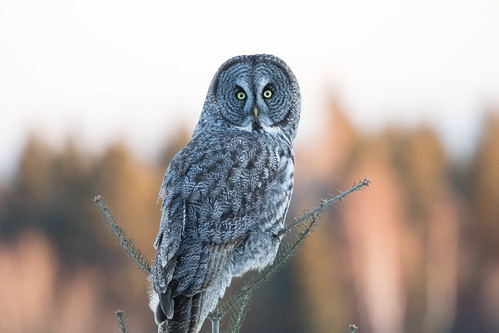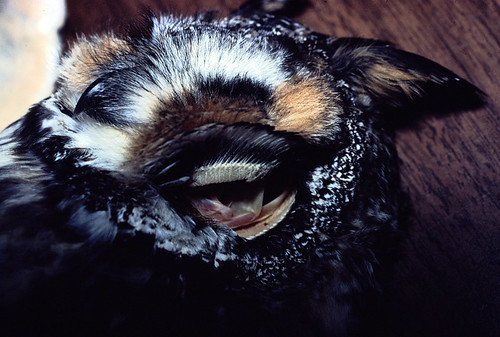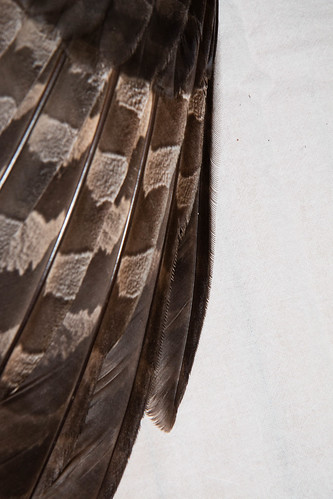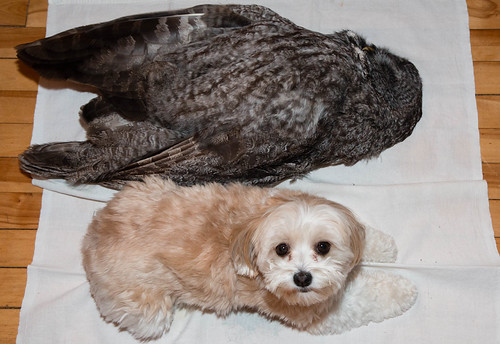The first Sunday of February tends to coincide with important annual rituals for many Americans. I spent the day, which I call Superb Owl Sunday, birding with my friend Lisa trying to find a superb owl, or even a standard one. Many more Americans call that day of the year Super Bowl Sunday and watch a football game rather than spending the day in nature looking for owls. Based on what we saw, we could have predicted the football game’s outcome: we encountered several Bald Eagles but not a single person who we could be sure was a patriot.
Unfortunately, we did not spot any owls. I’m afraid an owl tragedy earlier in the week may have caused our bad luck. My friend Erik Bruhnke, who has been staying with us this winter, came upon a dead Great Gray Owl on a roadside a bit northeast of Duluth. The poor bird’s body was in excellent condition except for being dead—it was presumably killed in a car collision. Erik salvaged it for an educational institution, but had to keep it at our house until he worked out a time to drop it off.
We took a few photos of it—there are some extraordinary features of owls that living birds hate to show off. I could tell that my little education owl Archimedes did not like me to show his ears to people, so I don’t approve of bird banders or other people pulling the facial disk forward to show the ears of a banded or education bird—I think the gush of air into the ear must hurt. When I want to show what owl ears look like, I use photos I took back after the infamous Halloween snowstorm of 1991. There was no way migratory owls could get food under that heavy, deep cover, and so people were finding dead owls, especially Long-eared Owls, as they shoveled out. So I photographed the ears, behind the facial disks, of an owl on its way to the Bell Museum.
I am dismayed to report that I didn’t even think to photograph this poor dead Great Gray Owl’s ears—that would have been truly fascinating, because their ears are humongous.
I did photograph the primary wing feathers, and got pretty good close-ups of the leading edge of the outermost one. That feather is responsible for the absolute silence of the owl’s flight—the rather stiff edge looks like a comb, the tiny teeth breaking up each wing’s whoosh into more than a hundred tiny whooshes.
I don’t think any bad Karma could be associated with those photos. The bad Karma that kept me from seeing a single owl on Superb Owl Sunday was because of another photo I got. The owl was huge—roughly 2 ½ feet long with a five-foot wingspan. That prompted me to weigh it—it weighed merely 3 pounds, which is on the heavy, well-fed side for a Great Gray. These birds are just feathers and spirit, and not a whole lot else.
I couldn’t help but compare that huge yet featherweight body with my dog Pip. She’s a tiny, fluffy dog, easy for me to pick up and carry with one hand; Pip weighs about 9 pounds. That gave me the idea to set her on the floor next to the owl for a size comparison. She did not like the idea, though she cooperated and was respectful of the poor owl, who was beyond caring. Sure enough, Pip is noticeably smaller than the owl, yet she weighs three times as much!
This all set me to wondering why the word “massive” is usually used to describe things of large volume, not mass. I’ve often read that the Great Gray Owl is massive, while no one larger than the tiniest mouse would ever describe Pip as massive—even our backyard squirrels laugh at her. Yet she’s fully three times more massive, in literal mass, than the largest owl in North America. Now I have a photo demonstrating the difference between mass and density, but it came at the cost of being punished on Superb Owl Sunday. With the Minnesota Vikings, all I can say is, “Maybe next year.”




